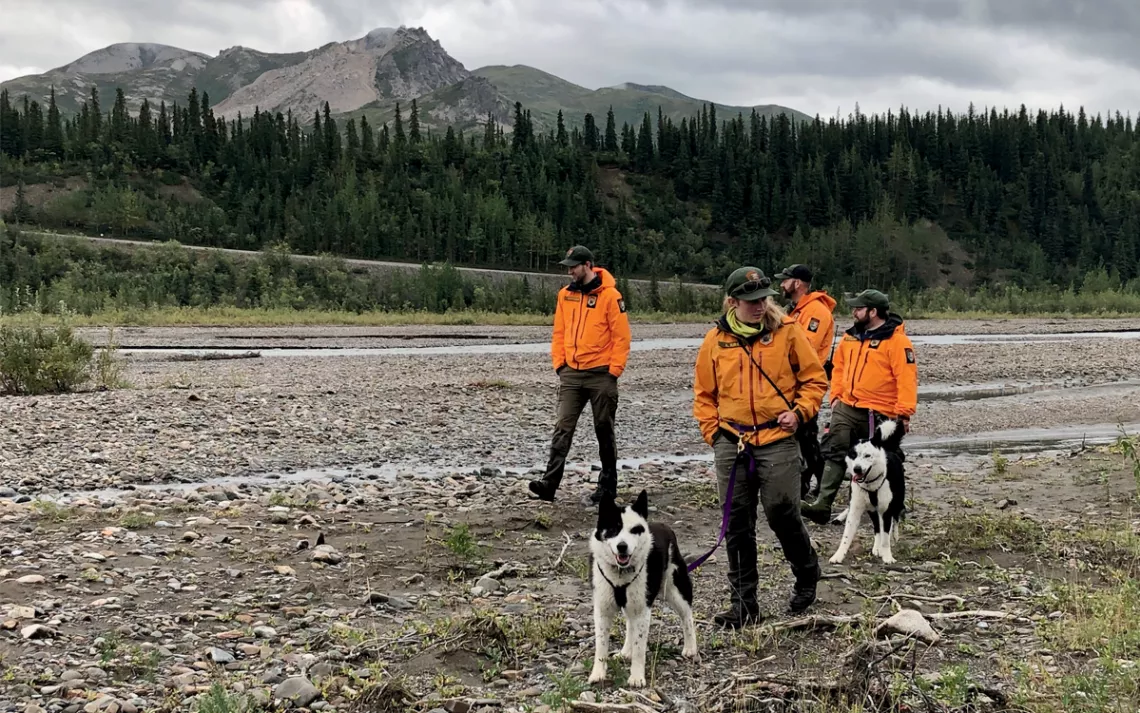Bear-Hunting Dogs Turn Into Bear Savers
In Alaska, trained Karelian bear dogs teach bears to avoid human danger

Karelian bear dogs, originally bred for hunting, now haze bears away from human settlements in Alaska. | Photo courtesy of Wind River Bear Institute
In July, near Seward, Alaska, a black bear entered a camper through an open door and scratched a sleeping man. It then raided nearby camps and charged people on a beach before state troopers killed it. A week earlier, a homeowner fatally shot a brown bear and her cub rummaging in an Anchorage neighborhood—just business as usual in the state's largest city, where in 2018 a record 14 grizzlies and 27 black bears were killed "in defense of life or property."
When bears tangle with humans, it's almost always the bear that loses. To prevent deadly conflicts, Alaska has adopted various strategies, from fencing landfills to shooing bears with firecrackers and rubber bullets.
The latest in bear-scare technology? Karelian bear dogs. Centuries ago, Scandinavian and Slavic peasants in the Finnish-Russian borderlands sculpted this husky-size breed for chasing brown bears and moose and for ambushing rats. Now the dogs are harassing bears a continent away, this time to save the bears' lives.
Fairbanks-born Nils Pedersen, a 36-year-old, stubble-faced wildlife biologist, first learned about Karelians through a crossbreed pup he adopted from a local litter. The mutt did well guarding a Yukon River fish camp, sounding the alarm at approaching bears. Through his own family history, Pedersen knew how effective dogs can be; a sepia-toned snapshot taken by his pole-hopping aviator grandfather shows a Greenland husky engaging a polar bear, almost "dancing with it."
To learn more, in 2011 Pedersen apprenticed at the Wind River Bear Institute in Florence, Montana. Besides inventing the bear-spray repellent that hikers carry, its founder, Carrie L. Hunt, pioneered the use of Karelian bear dogs to run off problem bears that would otherwise be killed. At the institute, Karelians are evaluated from eight to 10 weeks of age in a puppy version of America's Got Talent. Pups that fear crossing water, taxidermy mounts, culvert pipes, or bear hideouts don't make the grade—just one in four has the right stuff. Training starts during puppyhood, and certification takes up to four years. Older dogs mentor youngsters, as they work in tandem.
Pedersen, who says he "wasn't even that much into dogs" until his mid-twenties, now owns three full-blooded Karelian bear dogs and helps his girlfriend run 48 Siberian huskies at Arctic Dog Adventure outside Fairbanks, where they pull tourists to visit hot springs and to view auroras. His oldest is Soledad, a "very serious dog" with a piebald face and a comical black eye. Blaze-muzzled Rio II, an accomplished sled puller raised in Finland, sired Japan's first Karelian litter, to aid wildlife management there. The youngest is Soledad's pup Mardy, named after famed conservationist Margaret Murie.
As part of his master's, Pedersen had his dogs trail infrared-sensing drones to locate polar-bear dens on Alaska's North Slope. Since then, his wildlife K-9 team has been deployed at hotshot-firefighter camps and campgrounds and on the backstreets of Girdwood, a ski town near Anchorage. First he conducts drive-by surveys of ursine temptations: bear bait (legal in Alaska), bird feed, chicken coops, smokehouses, garbage cans. Then he brings in his canine partners, who can pick up bear scent from the camper shell on his truck going 60 miles per hour. They signal in individual voices, sharper, louder, and faster the closer they are to a target. Should the dogs fail to sufficiently annoy the trespassing bruins, Pedersen resorts to a slingshot, beanbags, or paintballs.
Pedersen trains his dogs to find bears "and dead things" exclusively. (A carcass might be a bear kill, a signal for him to loose his dogs.) During my visit, he and Mardy exited the truck for a demonstration. Earlier, he had dragged polar-bear skin pieces (donated from a deceased Alaska Zoo bear) and hidden them in brush dripping beneath sagging clouds. Mardy, straining in her harness, locked into the scentscape, her posture spelling attentiveness. On leash, she headed out through thickets, past blueberries like small grapes and rainsequined pink fireweed blooms. Before long, she sniffed out the day's first "bear," buried in moss. Having exhumed it, before even taking her smoked-salmon treat, she did what dogs do: Mardy squirmed and rolled on that raggedy scrap with abandon.
Part of Pedersen's job, he says, is education. "Teach your wildlife well" is the Wind River Bear Institute's motto. "Teach them to respect human spaces. And respect theirs as well." That lesson can be tough to get across in Alaska, where everyone is an armed bear expert. Luckily, handsome Karelians also excel at breaking the ice with skeptical audiences. Pedersen explains that the goal is not to rile or hurt the bears but to induce them to shun human environments—he calls it "shepherding." What bears need to know, he says, "is it's really easy to go back into the woods and really hard for them to come this way."
This article appeared in the Winter quarterly edition with the headline "Bears' Best Friend."
 The Magazine of The Sierra Club
The Magazine of The Sierra Club



